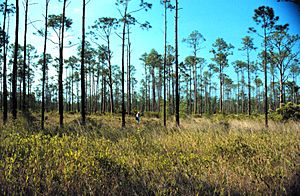Pre-Columbian savannas of North America facts for kids
North American savannas were special places with a mix of trees and grasslands. These areas were kept open by natural fires, like those started by lightning. Native Americans also used fire to manage these lands long before Europeans arrived. Even after many Native Americans got sick and died from new diseases in the 1500s, they still used fire to clear the savannas. When European settlers came, some continued this practice. But over time, some savanna areas turned back into thick forests.
Contents
How Savannas Formed After the Ice Age
About 18,000 years ago, a huge sheet of ice covered much of North America. This ice destroyed plants and made the weather very cold. South of the ice, plants like pine trees and a type of spruce tree grew a lot. This area also had many plant communities that needed fires to stay healthy, like the longleaf pine savannas. As the ice melted, these plants spread north into the newly uncovered lands.
Around 9,000 years ago, the weather became warmer and drier. This helped the prairies and savannas in the southeast grow bigger. Oak and hickory forests also became common. Plants that liked cooler weather moved north or to higher places. This change led to more pine forests in the Appalachian Mountains.
About 4,000 years ago, Native American groups began farming. They also started using fire more often. They burned plants on purpose to clear the forest floor, just like natural fires did. This made it easier to travel and helped useful plants like herbs and berries grow. These plants were important for food and medicine. In some places, Native American fires were like natural lightning fires. In other places, they changed the land a lot.
When European settlers arrived in the 1500s, many Native Americans died from diseases. This meant less burning and farming happened in large areas. Because of this, the forests started to grow thicker. What early Europeans saw was not a "wild" land untouched by humans. It was a land that was changing quickly because fewer Native Americans were there to manage it.
Where Savannas Used to Be
Savannas once surrounded the big central grasslands of North America. Fires also swept through the Rocky Mountains, creating open park-like areas. In the southwest, there were oak woodlands and Ponderosa Pine savannas. Further north, you could find Oregon White Oak savannas.
A large area called the Central Hardwood Region stretched from Minnesota down to Texas. The Eastern savannas of the United States reached all the way to the Atlantic Ocean.
In the southeast, longleaf pine trees were common in savannas and open forests. These forests once covered a huge area, about 92,000,000 acres (372,315 square kilometers), from Virginia to Texas. This was 36% of the region's land. Today, less than 1% of these original forests remain.
In the Eastern Deciduous Forest, frequent fires kept areas open. This helped large herds of bison live there. Native Americans who farmed often burned large parts of this forest every year. This created many large oak and white pine trees with very little undergrowth.
The Southeastern Pine Region, from Texas to Virginia, had longleaf, slash, loblolly, shortleaf, and sand pines. Natural lightning and humans burned the undergrowth of longleaf pine forests every 1 to 15 years. This continued from ancient times until people started stopping fires in the 1930s. However, burning to help wildlife continued and was common by the 1950s. Longleaf pine trees were dominant on the coastal plains until the early 1900s. Now, loblolly and slash pines are more common there.
In the Rocky Mountains, large areas of Ponderosa pine and Douglas fir forests were open and park-like until the 1900s. In California's Sierra Nevada mountains, frequent fires kept the ground clear under Ponderosa pines and giant Sequoia trees.
Why Savannas Disappeared
In the early 1900s, new sawmills cut down many tall savanna trees. Also, people started stopping fires in the 1930s and 1940s. This stopped the regular burning that savannas needed to survive. By the late 1900s, many scientists rediscovered how important fire was and how Native Americans used it. But by then, most savanna lands had been turned into farms or had grown into thick forests.
Today, people are trying to save savannas by using controlled burning. About 6,000,000 acres (24,281 square kilometers) are burned each year to help these special places.
Images for kids





